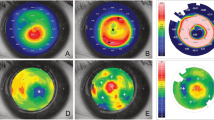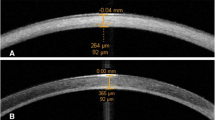Abstract
Corneal photoablation with the 193 nm argon fluorid excimer laser during photorefractive keratectomy (PRK) in high diopter range is frequently associated with subepithelial haze and consequent refractive regression due to avascular corneal wound healing. The wound healing response can be augmented by Ultraviolet-B (UV-B) exposure originating from sun or solarium. Clinically Laser in situ Keratomileusis (LASIK) even in high diopter range is associated with less subepithelial haze and regression than PRK. In an animal model, the morphologic changes of the rabbit cornea were evaluated following LASIK and secondary UV-B exposure. Light microsopic changes were found to be insignificant. Transmission electron microscopy (TEM) normal epithelium, epithelial adhesion structures and normal anterior stroma showed in the LASIK treated UV-B irradiated rabbit eyes. Around the peripheral LASIK cut, migrating keratocytes with pseudopodia were observed. Under the flap (160 μm depth) the overall stromal collagen structure was normal, some activated keratocytes and mild extracellular matrix formation within and around keratocytes were noted. Within activated keratocytes TEM showed prominent rough endoplasmic reticulum, Golgi apparatus, mitochondria and extracellular vacuoles, which showed resolution with time. These changes were much milder than in PRK treated-UV-B irradiated eyes. Secondary UV-B caused no long-term disturbance in corneal transparency in LASIK and UV-B treated rabbit eyes.
Similar content being viewed by others
References
Seiler T, Kriegerowski M, Kahle G, et al: Excimer laser keratomileusis for myopia correction. Results and complications. Klin Monatsbl Augenheilk 199:153–159, 1999.
Seiler T, Holschbach A, Derse M, et al: Complications of myopic photorefractive keratectomy with the excimer laser. Ophthalmology 101:153–160, 1994.
Tsubota K Toda I, Itoh S: Reduction of subepithelial haze after photorefractive keratectomy by cooling the cornea. Am J Ophthalmol 115:820–821, 1993.
Nagy ZZ, Németh J, Süveges I, et al: Examination of subepithelial haze after photorefractive keratectomy with the ultrasound biomicroscope. Klin Monatsbl Augenheilk 209:283–285, 1996.
Durrie DS, Lesher MP, Cavanaugh TB: Classification of variable clinical response after photorefractive keratectomy for myopia. J Cataract Refract Surg 11:341–347, 1995.
Grimm B, Waring Go III, Ibrahim O: Regional variation in corneal topography and wound healing following photorefractive keratectomy. J Refract Surg 11:348–357, 1995.
Siganos DS, Katsanevaki VJ, Pallikaris IG: Correlation of subepithelial haze and refractive regression 1 month after photorefractive keratectomy. J Refract Surg 15:338–342, 1999.
Wachtlin J, Langenbeck K, Schrunder S, et al: Immunohistology of corneal wound healing after photorefractive keratectomy and laser in situ keratomileusis. J Refract Surg 15:451–458, 1999.
Pallikaris IG, Siganos DS: Excimer laser in situ keratomileusis and photorefractive keratectomy for correction of high myopia. J Refract Corneal Surg 10:498–510, 1994.
Nagy ZZ, Hiscott P, Seitz B, et al: Ultraviolet-B enhances stromal response to 193-nm excimer laser treatment. Ophthalmology 104:375–380, 1997.
Knorz MC, Hermann A, Seiberth V, et al: Laser in situ keratomileusis to correct myopia of -6.00 to -29.00 diopters. J Refract Surg 12:575–584, 1996.
Marinho A, Pinto MC, Pinto R, et al: LASIK for high myopia: one year experience. Ophthalmic Surg Lasers 1996;27:S517–520.
Kim HM, Jung HR: Laser assisted in situ keratomileusis for high myopia. Ophthalmic Surg Lasers 1996;27:S508–511.
Hersh PS, Brint SF, Maloney RK, et al: Photorefractive keratectomy versus laser in situ keratomileusis for moderate to high myopia. A randomized prospective study. Ophthalmology 105:1512–1522, 1998.
Knorz MC, Wiesinger B, Hermann A, et al: Laser in situ keratomileusis for moderate and high myopia and myopic astigmatism. Ophthalmology 105:932–940, 1998.
McGhee CN, Craig JP, Sachdev N, et al: Functional, psychological and satisfaction outcomes of laser in situ keratomileusis for high myopia. J Cataract Refarct Surg 26:497–509, 2000.
Hanna KD, Pouliquen YM, Waring GO III, et al: Corneal wound healing in monkeys after repeated excimer laser photorefractive keratectomy. Arch Ophthalmol 110:1286–1291, 1992.
Chayet AS, Assil KK, Montes M, et al: Regression and its mechanism after laser in situ keratomileusis in moderate and high myopia. Ophthalmology 105:1194–1199, 1998.
Maldonado MJ, Ruiz-Oblitas L, Munuera JM, et al: Optical coherence tomography evaluation of the corenal cap and stromal bed features after laser in situ keratomileusis for high myopia and astigmatism. Ophthalmology 107:81–87, 2000.
Wang Z, Chen J, Yang B: Comparision of laser in situ keratomileusis and photorefractive keratectomy to correct myopia from -1.25 to -6.0 diopters. J Refract Surg 13:528–534, 1997.
Corbett MC, O’Brart DP, Warburton FG, Marshall J: Biologic and environmental risk factors for regression after photorefractive keratectomy. Ophthalmology 103:1381–1391, 1996.
Fagerholm P: Wound healing after photorefractive keratectomy. J Cataract Refract Surg 26:432–447, 2000.
Fagerholm P, Hamberg-Nyström H, Tengroth B: Wound healing and myopic regression following photorefractive keratectomy. Acta Ophthalmol Copenh 72:229–234, 1994.
Weber BA, Fagerholm P, Johansson B: Colocalization of hyaluronan and water in rabbit corneas after photorefractive keratectomy by specific staining for hyaluronan and by quantitative microradiography. Cornea 16:560–563, 1997.
Helena MC, Baerveldt F, Kim WJ, Wilson SE: Keratocyte apoptosis after corneal surgery. Invest Ophthalmol Vis Sci 39:276–283, 1998.
Wilson SE: Keratocyte apoptosis in refractive surgery. Everett Kinsey Lecture. CLAO 24:181–185, 1998.
Podskochy A, Fagerholm P: Cellular response and reactive hyaluronan production in UV-exposed rabbit corneas. Cornea 17:640–645, 1998.
Podskochy A, Gan L, Fagerholm P: Apoptosis in UV-exposed rabbit corneas. Cornea 2000. 19:99–103.
Fitzsimmons TD, Molander N, Stenevi U, et al: Endogenous hyaluronan in corneal disease. Invest Ophthalmol Vis Sci 35:2774–2782, 1994.
Vinciguerra P, Azzolini M, Radice P, et al: A method for examining surface and interface irregularities after photorefractive keratectomy and laser in situ keratomileusis: a predictor of optical and functional outcomes. J Refract Surg 14 S204–206, 1998.
Amm M, Wetzel W, Winter M, et al: Histopathological comparision of photorefractive keratectomy and laser in situ keratomileusis. J Refract Surg 12:758–766, 1996.
Helena MC, Meisler D, Wilson SE: Epithelial growth within the lamellar interface after in situ keratomileusis (LASIK). Cornea 16:300–305, 1997.
Wilson SE, Mohan RR, Mohan RR, et al: The corneal wound healing response: cytokine-mediated interaction of epithelium, stroma, and inflammatory cells. Progress Ret Eye Res 20:625–637, 2001.
Author information
Authors and Affiliations
Rights and permissions
About this article
Cite this article
Nagy, Z.Z., Tóth, J., Nagymihály, A. et al. The role of ultraviolet-B in corneal healing following excimer Laser in situ Keratomileusis. Pathol. Oncol. Res. 8, 41–46 (2002). https://doi.org/10.1007/BF03033700
Received:
Accepted:
Issue Date:
DOI: https://doi.org/10.1007/BF03033700




